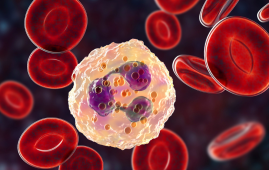

A Hong Kong Baptist University (HKBU)-led research team has created a unique drug delivery mechanism for Alzheimer’s disease (AD). The researchers designed exosomes, which are extracellular vesicles released by cells, to transport the bioactive chemical Corynoxine-B derived from the Chinese herbal remedy Gouteng to the brains of mice with Alzheimer’s disease. Because Corynoxine-B induces autophagy, a process that maintains cell health, this innovative medication delivery system based on exosomes has the potential to improve cognitive function and movement while alleviating the symptoms of Alzheimer’s disease.
The outcomes of the study were published in Nature-Signal Transduction and Targeted Therapy, an international academic magazine.
Gouteng’s bioactive ingredient may be used to treat Alzheimer’s disease
The most common type of dementia is Alzheimer’s disease (AD), in which brain cells deteriorate and die due to a buildup of amyloid-beta and phospho-tau protein in the brain, leading in a decrease in cognitive functioning. Dementia affects more than 55 million individuals globally today. More than 100,000 older people in Hong Kong suffer from dementia, with the figure expected to rise to more than 330,000 by 2039.
There is currently no cure for Alzheimer’s disease. The available treatments can only slow the progression of the disease and ameliorate symptoms. Previous HKBU research initiatives discovered that Corynoxine-B, a bioactive ingredient of Gouteng, is useful in the treatment of Alzheimer’s disease. The blood-brain barrier, which protects the brain from potentially dangerous compounds in the bloodstream, does, however, influence its uptake in the brain.
Exosomes are medication transporters
To address this issue, a research team led by Professor Li Min, Associate Dean (Teaching and Learning) of Chinese Medicine, and Dr Ashok Iyaswamy, Research Assistant Professor of the Teaching and Research Division at the School of Chinese Medicine at HKBU, in collaboration with other local, mainland, and international scientists, developed a novel method for delivering Corynoxine-B to the brain via exosomes.
Exosomes are extracellular vesicles generated by cells that, like nanocarriers, can transfer chemicals between cells. According to recent research, they could be used as drug delivery vehicles. The researchers modified neuronal cells in mice to overexpress an adapter protein Fe65 on the surface of exosomes generated by these cells to test whether exosomes are effective medication carriers for AD. Fe65 is involved in the processing of amyloid-beta precursor protein (APP), which is essential in the development of Alzheimer’s disease.
They discovered that neuronal cells released more exosomes containing Fe65 as a result. These modified exosomes demonstrated a high propensity to move toward neuronal cells expressing APP in AD mice. These findings imply that the presence of Fe65 on the surface of exosomes improved their ability to preferentially target and interact with neuronal cells containing high levels of APP, which is a hallmark of Alzheimer’s disease.
Reduced amyloid-beta protein accumulation
Corynoxine-B is a natural inducer of autophagy, which is essential for brain health. The researchers put it into modified exosomes and injected it into AD mice to assess its potential as a therapeutic agent. The results reveal that modified exosomes laden with Corynoxine-B may boost autophagy in mice and pass the blood-brain barrier to transfer Corynoxine-B to the brain, resulting in a 30% reduction in amyloid-beta protein accumulation.
Furthermore, various behavioral tests on mice with AD, including the rotarod test, open field test, contextual fear conditioning test, and Morris’ water maze test, revealed that the application of engineered exosomes loaded with Corynoxine-B resulted in a 25% recovery of cognitive and locomotor behavior.
“Our study suggests that exosomes could be a promising new way to deliver drugs to the brain and treat AD. More research is needed, but this study provides hope that a cure for AD may be possible in the future. We hope that this research project will ultimately be beneficial to the elderly, individuals at high risk of neurodegeneration and neurodegenerative disease patients.” – Professor Li Min, Associate Dean of Chinese Medicine, HKBU
more recommended stories
 Circadian Control of Neutrophils in Myocardial Infarction
Circadian Control of Neutrophils in Myocardial InfarctionKey Takeaways for HCPs Neutrophil activity.
 E-Cigarette Use and Heart Attack Risk in Former Smokers
E-Cigarette Use and Heart Attack Risk in Former SmokersKey Takeaways for Clinicians and Nurses.
 36-Week Pre-eclampsia Screening May Reduce Term Risk
36-Week Pre-eclampsia Screening May Reduce Term RiskA New Preventive Strategy for Term.
 Cardiovascular Risk and Sudden Cardiac Death in Diabetes
Cardiovascular Risk and Sudden Cardiac Death in DiabetesRising Sudden Cardiac Death (SCD) Risk.
 Poor Kidney Function and Alzheimer’s Biomarkers Explained
Poor Kidney Function and Alzheimer’s Biomarkers ExplainedPoor kidney function may influence levels.
 Walking Speed Before Hip Replacement Predicts Recovery
Walking Speed Before Hip Replacement Predicts RecoveryNew Evidence Points to a Simple,.
 Neuroblastoma Drug Combo Extends Survival in Models
Neuroblastoma Drug Combo Extends Survival in ModelsA Promising Shift in High-Risk Neuroblastoma.
 How Soybean Oil Impacts Weight Gain and Metabolism
How Soybean Oil Impacts Weight Gain and MetabolismWhy Soybean Oil May Affect Metabolism.
 Coffee and Cognitive Function: Evidence Review
Coffee and Cognitive Function: Evidence ReviewA new narrative review in Cureus.
 Colorectal Cancer Screening Rates Low in Adults 45–49
Colorectal Cancer Screening Rates Low in Adults 45–49Recent UCLA research reveals that colorectal.

Leave a Comment